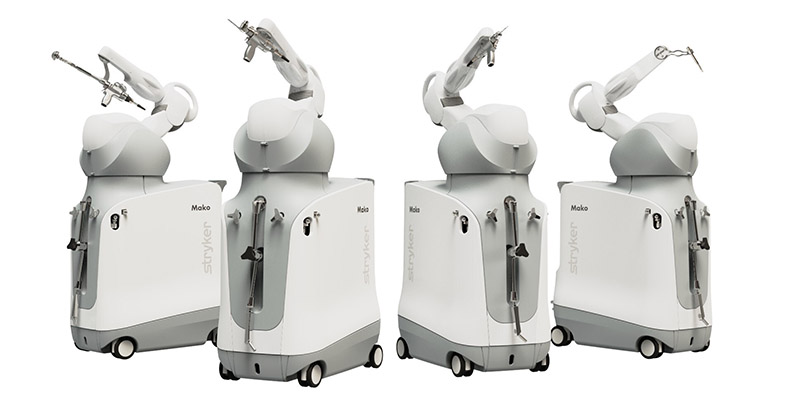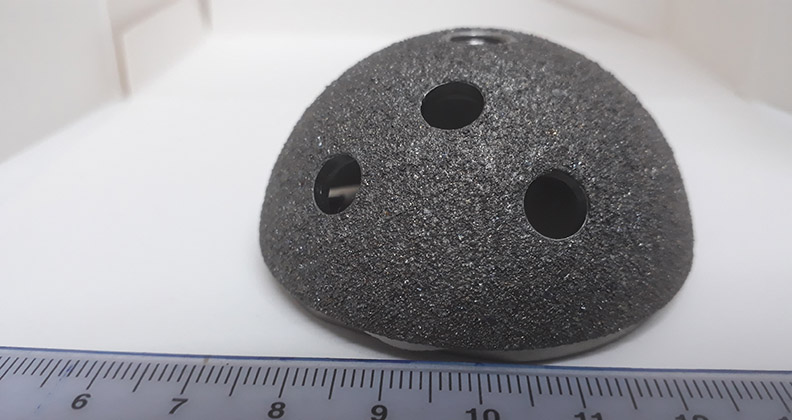
Dimension Inx, an advanced materials and biofabrication company, plans to bring new 3D-printable materials and medical devices to market to aid tissue repair and bone regeneration in orthopedic applications.
The company’s materials platform, which consists of a patented 3D-painting materials design and manufacturing system, allows for many kinds of biomaterials to be rapidly 3D-printed. Each of their individual 3D-paints can be 3D-printed at room temperature via direct extrusion, and the material and/or the object dries near instantaneously, without needing sintering, curing, or crosslinking.
“The materials solidify in the same way as paint on a wall would, via evaporation,” said Adam Jakus, Ph.D., Co-Founder and Chief Technology Officer at Dimension Inx. “We also call them 3D-paints because all of these materials can be co-3D-printed with each other, analogous to an artist painting multiple colors on a canvas.”
Also similar to painting, 3D-paints can be mixed for a gradient effect using the Dimension Inx technology. One material intended for bone, for example, can be blended with another 3D-paint that is intended for cartilage or muscle tissue, creating a gradient tissue.
“The particles that we use determine the functionality of these 3D-paints; that’s one of the distinguishing factors between us and regular household paint, where the particles are pigment,” said Ramille Shah, Ph.D., Co-Founder and Chief Scientific Officer at Dimension Inx. “The particles in our 3D-paints are really for function. To have multifunction within one device is what allows us to target certain areas in tissue repair and regeneration.”
Robust Material Properties
Dimension Inx’s initial focus is regenerative medical devices made from an elastomeric and bioactive ceramic called Hyperelastic Bone®, a calcium phosphate-based 3D-paint that is used to create surgically friendly, flexible implants that actually generate new bone.
Hyperelastic Bone® can be rapidly 3D-printed at room temperature into simple or complex structures that can be patient matched or generically shaped. Ninety percent of the 3D-printed structure’s weight is calcium phosphate, the same material found in human bones.
“Bones are brittle and they break, so you’d think that a material like Hyperelastic Bone® with so much calcium phosphate in it would be brittle,” Dr. Jakus said. “But what makes this formulation unique is that, despite being mostly ceramic, it’s not brittle. It can be cut; it can be rolled in a thin sheet form. It’s very easy to handle and surgically implement.”
Traditionally, 3D-printed polymers have good handling properties but poor bioactive properties, and 3D-printed ceramics have good bioactive properties but poor handling properties. Hyperelastic Bone® has both good handling and good bioactive properties, according to the co-founders.
Orthopedic bone products that have very high ceramic content typically come in granule form or putties that are mixed with polymers. Though Hyperelastic Bone® is mostly ceramic, it is robust enough to stay together without crumbling when cut or manipulated.
“We have the ability to tune the properties and make flexible products from Hyperelastic Bone®; you can bend and fold them, or create thin meshes, all the way to more robust and rigid materials that are sometimes needed for structural applications,” Shah said. “We have this window of varied mechanical properties which we can change for different bone targets, from craniomaxillofacial applications all the way to spine.”
 A Regenerative Advantage
A Regenerative Advantage
Beyond replacing bone with an implant, Hyperelastic Bone® can actually regenerate bone in several applications including cranial defects, spinal fusion and long bones.
“Our in vivo work in animals has shown Hyperelastic Bone® to be able to regenerate bone in a variety of different animal models,” Dr. Shah said. “We’ve used it from small animals all the way to a case study in a monkey model. We’ve seen that Hyperelastic Bone® integrates very rapidly to tissue, vascularizes within a couple of weeks of implantation, and stabilizes very quickly compared to other types of implants that are made of similar materials. Over time, it remodels and starts to regenerate bone.”
Tests have shown that Hyperelastic Bone® maintains its shape and becomes more rigid over prolonged time, indicating strong promise for human use.
Current 3D-printed and non-3D-printed materials that are made of titanium, stainless steel, PEEK or porous polyethylene and other traditional medical materials are meant to provide structural support. Dimension Inx 3D paints, Hyperelastic Bone® included, are intended to transform into natural tissue.
“Other companies are also developing regenerative approaches, and they’re 3D-printing ceramics or adding large quantities of growth factors or cells to their materials to get that generative response,” Dr. Jakus said. “We don’t need to add large quantities of growth factors or cells for our material to get that regenerative response, and we have all the good things about ceramics without all the difficult handling properties.”
Because the devices are 3D-painted, the porosity and architecture of the structures can also be tailored.
“It is shown that the architecture and porosity of an implant or device does make a huge difference in a biological response,” Dr. Shah said. “I think that is what gives us the advantage of being able to have the ideal pore size that allows for best integration, remodeling and degradation.”
What’s on the Horizon?
Dimension Inx is moving toward FDA clearance, targeting approval within the next couple of years for the first product, with new technologies and opportunities in the orthopedic space to follow.
“Our main objective is to develop our own products and partner with strategics to get distribution and sales down the road,” Dr. Shah said. “We look at it more as the innovation hub, where we work with these partners to develop new devices that are either based on our materials, or they have their own materials that they want to print using our process to generate new products in their portfolio.”
There’s no doubt that 3D-printing is becoming more common in orthopedics, but Dimension Inx’s approach is to think about what kind of materials can be designed for 3D-printing.
“You’re no longer necessarily fixed to titanium and plastics. You could design entirely new materials,” Dr. Jakus said. “If you had an ideal material, what would it be? Dimension Inx is in a place now where we could probably design that material.”
HT
Heather Tunstall is a BONEZONE Contributor.




